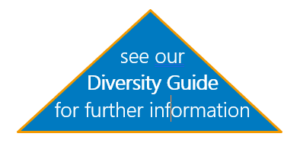
Addressing sex and gender identity discrimination and inequalities means meeting the different needs of women and men while being aware that this includes men and women who are transgender as well as those who are not.
It also involves taking account of the legitimate needs and aspirations of people who are non-binary, intersex or with any other gender definition, although not technically ‘protected characteristics’ under the Equality Act.
In 2019 we published our Breastfeeding Statement and launched the Positive About Breastfeeding scheme.
2018 was Vote100 – find out how we celebrated the centenary of women first gaining a right to vote.

- Gender identity
Sex and gender identity are quite complex issues, and the terminology can be quite confusing. The key point to bear in mind is that for the great majority of people, the sex (physical features) they were born with matches the way they think about themselves. For some, however, there’s a conflict: people develop as male or female in their heads and in their character, but their body is saying the opposite. This conflict may be due to hormonal events during their time in the womb (it should be made clear that these events are not the responsibility of the mother; they just happen sometimes). The conflict can become evident in early years, around 4 or 5, and can build into a very stressful situation around and after puberty. This condition is called “gender dysphoria” and people who are born with it are called “transgender”. It is rare and affects around one per 10,000 or 20,000. Some people are born with ambiguous reproductive organs – this is often known as “intersex” rather than “hermaphrodite” which has been used historically and is used in relation to species that do not have separate male and female sexes.
Once gender dysphoria is medically diagnosed, most transgender people choose to live in their true gender. As part of transitioning, people may or may not undertake medical intervention (“sex change”) in the form of hormone therapy, physical surgery, or both.
When someone has finished transitioning and is living fully in their true gender. Many prefer to identify as “formerly transgender” rather than continue to identify as transgender, since they are now living fully as a man or woman. Or they may simply identify as male or female. Nowadays the term transgender is being used far more than transsexual.
Transgender people have legal protection against discrimination from the moment that they announce they intend to transition. Once people have transitioned they must be allowed to live their lives in their true gender without having to refer back to how they were previously. Schedule 3 Part 7 (28) of the Equality Act does allow a service provider to discriminate (for example, exclude) someone on grounds of gender reassignment in relation to the provision of same-sex services where this is a ‘proportionate means of achieving a legitimate aim’. For example, it may be reasonable to exclude a trans woman who still has male sex appearance from accessing women’s shared facilities if it could put those women at a disadvantage.
Some people prefer not to identify as either male or female or shift freely between the two: they may define as “non-binary”, “gender fluid” or “third sex”, or with some other term that they feel comfortable with. People who wish to live a non-binary life will usually make this clear, and will suggest appropriate pronouns to use in reference to them (e.g. some suggest we use “their” instead of “his” or “hers”). In the UK, non-binary people do not at the moment have the same legal protections for their gender identity that transgender people have, so it is a matter of social responsibility for others to set good standards for being inclusive and positive.
Transvestites are not necessarily transgender; there are many people who do not have a gender-conflict but nevertheless enjoy dressing or living for a while as the opposite sex, as part of their erotic life, or just for pleasure and fun.
The general term “Trans” is often used to positively include all those who are or were transgender, as well as those who are transvestite, non-binary or gender-variant of any kind.
It should not be assumed that Trans people are necessarily without child-rearing responsibilities. Trans people are often parents, either as a result of previous relationships or as adopters or fosterers. The same can apply to lesbian, gay and bisexual people.
For more information and guidance on ensuring access for Trans people, please see our LGBT Toolkit for Excellence.
- Gender and sex equality
Most services are gender neutral in that they are available to anyone regardless of their sex/gender, but sex/gender can be a factor in terms of how easy it is to access that service or a person’s experience/confidence in using a service (for example, where women have a greater dependence upon public transport or may be concerned about sexual harassment). Some health and social care interventions require a sex/gender specific response such as cancer screening and personal care.
Women experience many inequalities in society still and both boys and girls may experience bullying at school because they do not confirm to current gender stereotypes. Many inequalities faced by women arise from perceptions and values attributed to their child bearing/caring role, although women do not necessarily spend the majority of their time having or raising children! Other inequalities and patronising behaviours arise from outdated beliefs that women are weaker, delicate, or less capable than men. The over sexualisation and objectification of women also leads to higher levels of harassment, sexual assault and other demeaning behaviour towards women. Men can also experience prejudice and discrimination when they take on stereotypically female roles such as being the main child-carer.
In 2011 we carried out a study to identify and address any problems experienced by pregnant women at work, women on maternity leave and women who have left or returned to work following the birth of their baby. The Equality Act 2010 introduced provisions which make it unlawful to ban women from breastfeeding in public.
We are pleased to have a gender equality representative on our Equality Reference Group, from Fawcett Devon. Over the years, we have also increased the ratio of women in senior management roles. Transgendered people’s needs and issues are also represented on our Equality Reference Group by the LGB&T representative (also see the section on Sexual Orientation). In 2019 we changed single-unit toilets to be gender-neutral at County Hall and are looking at ways of increasing gender-neutral facilities where this is feasible (for example, in single-unit facilities).